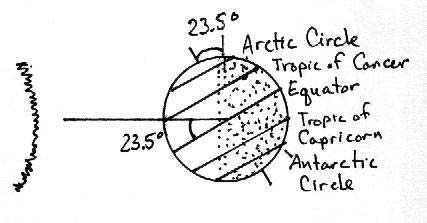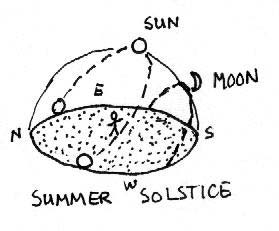Or have you noticed the sun in the past few days? The days are really long, so long that many people are in bed before it gets very dark. During the day, it rises in the northeast and makes a long, high arc high in the sky before setting in the northwest.
You probably remember from school, or have been reminded by almost any calendar in circulation, that these long days are associated with the first day of summer, or the summer solstice. The solstice will occur on Saturday, July 21, shortly after 3:00 PM EDT.
But what causes the changing seasons, and why do our nearest neighbors appear in such radically different places in the sky at different times of year?
 The Sun, Earth, and the Moon are all on roughly the same plane, but Earth's axis, the line running through the North South Poles, is tilted 23.5 degrees. As the Earth orbits the Sun, this tilt remains the same, but the orientation of the axis relative to the sun changes.
The Sun, Earth, and the Moon are all on roughly the same plane, but Earth's axis, the line running through the North South Poles, is tilted 23.5 degrees. As the Earth orbits the Sun, this tilt remains the same, but the orientation of the axis relative to the sun changes.Try this: Hold your left fist in front of your face. Hold a pencil in your right hand and tilt it towards the left so that it points to 11:00. Your left hand is the Sun, and the pencil is Earth's axis. Notice that the top of the pencil is closer to your fist than the bottom. Next, still pointing at 11:00, move the pencil to the far side of your Sun-fist. Now the top and bottom of the pencil are equally far from the fist. If you can orbit the pencil another 90 degrees without dislocating your shoulder, the bottom of the pencil will be nearer to the fist than the top. Then when the pencil is between you and your fist (you'll have to cheat to get into position), both ends will be equally far away again.
You've just mimicked Earth's orbit of the sun. Sometimes the top points sunward, sometimes the bottom does, and sometimes neither does.

The summer solstice is the day when the North Pole and Earth's axis are pointed most directly towards the sun. The brunt of the Sun's light hits the Tropic of Cancer (23.5 degrees north of the equator) and we in the northern hemisphere are tilted into the ecliptic so that the Sun makes has a high, long path through the sky. The Moon, meanwhile, is on the same ecliptic, but on the other side of the planet, so it traces a short and low arc. Above the Arctic Circle (23.5 degrees from the North Pole - there's that number again!), the Sun never sets on the summer solstice.
Of course, everything is reversed for folks in the Southern Hemisphere, and in six months, everything will be reversed again for all of us.
 Don't be fooled into thinking that summer is hot because it's when we are closest to the Sun. In the first place, we aren't closest now, and won't be until the first of the year. And even if we were, how would you explain those Australian July winters? They are just as far from the Sun as we are in the Northern Hemisphere. No, what makes summer hot is the long path of the sun and the long hours the sun is up.
Don't be fooled into thinking that summer is hot because it's when we are closest to the Sun. In the first place, we aren't closest now, and won't be until the first of the year. And even if we were, how would you explain those Australian July winters? They are just as far from the Sun as we are in the Northern Hemisphere. No, what makes summer hot is the long path of the sun and the long hours the sun is up.So why isn't June 21 the hottest day of the year? Blame it on the oceans. They are slow to warm up, and will keep the earth from reaching full warmth for several more weeks. Again, this will reverse in the winter, when their slow cooling holds off the coldest weather until February or so.
Mars watch: On Thursday morning, June 19, look for Mars near the waning gibbous moon.

The Piker Press moderates all comments.
Click here for the commenting policy.